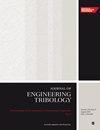温度对简化活塞缸摩擦力测量的影响:挤压膜结合最小油膜厚度测量和粘度指数效应
IF 1.8
3区 工程技术
Q3 ENGINEERING, MECHANICAL
Proceedings of the Institution of Mechanical Engineers, Part J: Journal of Engineering Tribology
Pub Date : 2023-06-06
DOI:10.1177/13506501231177484
引用次数: 0
摘要
活塞环和衬套处的润滑界面及其与不同润滑剂和测试条件的相互作用通过实验测量来检验,实验测量显示在润滑处或取决于部分润滑连接的条件下形成的最小油膜厚度和表面相互作用强度,这是由摩擦传感器测量的。在简化活塞环模拟试验台上,采用不同的实验参数和不同的润滑油进行了分析。通过对接近冲程逆转的挤压膜效应的研究,以及先前实验数据的空化引发和负载效应的结果,进一步加强了这一分析,揭示了不同润滑制度下相互作用表面的行为。另一个参数,润滑剂的粘度指数被用来表示挤压膜位移和摩擦力测量的影响,以及负载和温度效应如何影响挤压膜。本文章由计算机程序翻译,如有差异,请以英文原文为准。
On the effect of temperature in friction force measurements for a simplified piston cylinder set-up: Squeeze film combined with minimum oil film thickness measurements and viscosity index effect
The lubricated interface at the piston-ring and liner and its interaction with different lubricants and testing conditions is examined in terms of experimental measurements that show the minimum oil film thickness developed at the lubricated or depending on conditions partly lubricated conjunction and the surface interaction intensity, as measured from the friction sensor. An analysis is carried out with the use of different parameters for the experiments as well as different lubricants in a simplified piston-ring simulation test rig. This analysis is further enhanced with the squeeze film effect investigations close to the stroke reversals and together with cavitation initiation and load-carrying effect results from previous experimental data, light is shed on the interacting surface’s behaviour at the different lubrication regimes. Another parameter, the viscosity index of the lubricant is used as an indication of the effects of squeeze film shift and friction force measurements and how the load and temperature effect are influencing the squeeze film.
求助全文
通过发布文献求助,成功后即可免费获取论文全文。
去求助
来源期刊

CiteScore
4.20
自引率
5.00%
发文量
110
审稿时长
6.1 months
期刊介绍:
The Journal of Engineering Tribology publishes high-quality, peer-reviewed papers from academia and industry worldwide on the engineering science associated with tribology and its applications.
"I am proud to say that I have been part of the tribology research community for almost 20 years. That community has always seemed to me to be highly active, progressive, and closely knit. The conferences are well attended and are characterised by a warmth and friendliness that transcends national boundaries. I see Part J as being an important part of that community, giving us an outlet to publish and promote our scholarly activities. I very much look forward to my term of office as editor of your Journal. I hope you will continue to submit papers, help out with reviewing, and most importantly to read and talk about the work you will find there." Professor Rob Dwyer-Joyce, Sheffield University, UK
This journal is a member of the Committee on Publication Ethics (COPE).
 求助内容:
求助内容: 应助结果提醒方式:
应助结果提醒方式:


